Vanda Felbab-Brown discusses the state of the U.S.-Mexico security cooperation framework, the Mérida Initiative, and the lack of will by President Andrés Manuel López Obrador to confront Mexico’s criminal groups. This piece was originally published by Mexico Today.
Earlier this week, Mexico’s Foreign Minister Marcelo Ebrard declared the Merida Initiative, the $3 billion U.S.-Mexico security cooperation framework in place since the Felipe Calderón and George W. Bush administrations, “dead.” The announcement is both an overstatement, since U.S. money to Mexico for the development of rule-of-law institutions is still flowing, and an understatement of the collapse of much of U.S.-Mexico anti-crime cooperation; but it is no surprise. Since he was elected President Andrés Manuel López Obrador has sought to end the Merida Initiative and has systematically eviscerated U.S.-Mexico security cooperation, and worse yet, Mexico’s efforts against drug trafficking groups and violent criminality in Mexico and against drug trafficking to the United States. Even though Minister Ebrard speaks of ways to renegotiate and reorient the Merida Initiative, something the United States has been suggesting since López Obrador came to power, and even though high-level U.S.-Mexico security meetings are to take place in November, there is, in fact, little prospect for relaunching robust cooperation or for the López Obrador administration adopting more effective policies against Mexican criminal groups instead of yielding to them as has been the case up to now.
In Mexico, the Merida Initiative is often portrayed as a catastrophe forced onto Mexico by the United States, that set off the drug wars in Mexico which consists solely of killing the leaders of Mexican drug trafficking organizations (DTOs). In fact, after decades of failing security policies in Mexico and intensifying violence, the Calderón administration in an unprecedented step reached out to the United States to request security collaboration to counter the DTOs who had not only deeply infiltrated law enforcement and security institutions in Mexico, but also unleashed a series of turf wars and efforts to control territories, featuring the extortion of businesses and control of local populations. At Mexico’s request, the initial version of the Merida Initiative consisted principally of equipment and technology transfers and intelligence cooperation to go after drug capos, alongside President Calderón’s deployment of the Mexican military to replace the failing and corrupt local and state police forces and federal law enforcement institutions. When the Barack Obama administration came to power, it persuaded the Calderón government to reorient and expand Merida to include other key components, with the four so-called Pillars becoming:
I. the strengthening of rule of law institutions, including police forces – with the Federal Police having been the centerpiece of U.S. police building efforts – the justice system, and corrections facilities;
II. targeting DTOs;
III. modernizing the U.S.-Mexico border to facilitate speedy trade while countering illicit flows; and
IV. building communities resilient against the influence of and penetration and domination by criminal groups.
Problematically, the countering of DTOs came to center on so-called high-value targeting — namely, arresting and taking down the criminal capos. Over the years, I have extensively criticized high-value targeting (HVT), narrowly defined as countering the capos, as inadequate and counterproductive: Inadequate, because criminal bosses are easy to replace and many of the replacements have turned out to be far more violent than the previous leaders; and counterproductive because in the Mexican context it has exacerbated DTO fragmentation and diversification, producing various illegal economies and intensified turf wars, since law enforcement forces have not managed to control territories and create deterrence effects.
Overall, progress along those four pillars has been uneven – because of structural reasons, design deficiencies, massive persisting weaknesses and corruption in Mexican institutions, the lack of sustained funding, and the wavering attention and priorities of successive Mexican administrations. For example, the Calderón administration initially lacked interest in Pillar IV, building resilient communities (these efforts being funded mostly the U.S. Agency for International Development, USAID); but then, amidst a political scandal, the Calderón administration embraced Pillar IV and operationalized it as a massive government anti-crime development program, Todos Somos Juárez, focused on one city, Cuidad Juárez. The subsequent Enrique Peña Nieto administration took most of the money away from Todos Somos Juárez and dispersed it and the anti-crime socio-economic development funding among an evolving number of the most crime-ridden communities. But within a few years, the Peña Nieto administration completely stopped funding those programs. Those that plodded on were funded essentially by USAID. The Peña Nieto administration made other changes to the Merida Initiative, such as dismantling joint Mexican-U.S. intelligence centers.
The López Obrador administration is not wrong to seek adjustments to the U.S.-Mexico security framework and to want to walk away from HVT. Nor is it wrong in formally defining as its priority the reduction of homicides in Mexico.
However, the López Obrador administration is fundamentally wrong in simply giving up on confronting Mexico’s criminal groups. A viable alternative security policy to HVT does not involve simply yielding to the DTOs and criminal groups. Yet this is precisely what the Mexican government has done, failing to mount any effective strategy for reducing homicides.
There are various ways to design law enforcement strategies to minimize violence while taking on criminal groups, including targeting middle layers of DTOs, concentrating law enforcement and socio-economic resources to create expanding concentric circles of security, prepositioning of forces to avoid violent flareups, targeting the most violent groups, and designing interdiction to minimize violent turf wars.
But not only does López Obrador administration lack any law enforcement strategy, it is, in fact, not interested in having one, if that would entail tackling the criminal groups. In its abandonment of high-value targeting it has relinquished taking on criminal groups in any significant way. Its amorphous and ill-defined generic programs for Mexican youth, valuable as they may be for a variety of other reasons, are not an adequate and meaningful law enforcement strategy.
With the exception of its efforts to protect Pemex from extortion and pipeline bunkering, the current Mexican government has exhibited no interest in countering Mexican criminal groups with the country’s law enforcement forces. Dramatic examples abound: failing to respond to the Sinaloa Cartel’s seizure of Culiacán and turning the city into an urban warfare zone; López Obrador’s shaking hands with El Chapo’s mother and condemning El Chapo’s sentence in the United States; praising security forces for not resorting to use of force whether when police stations are burned down or mobs lynch alleged criminals or attack government offices; the government’s meek nonresponse to the brazen DTO attack on the top law enforcement official in Mexico City, Omar García Harfuch, in the city’s center; passive acceptance of territories under control of narcos; the Mexican president’s praise of criminal groups for allowing Mexico’s mid-term elections to take place without violence even while scores of candidates were assassinated or intimidated during one of the most violent electoral campaigns, as tens of millions of narco-dollars are believed to have been challenged into electoral campaigns.
The message to Mexican criminal groups has been clear: You can get away, not just with intimidation and murder, but with brazen intimidation and murder. And if you support López Obrador’s MORENA party, you can ensure no actions will be taken against you for years to come, leaving you with a free hand to resort to violent and infiltrate all layers of the Mexican government.
At the same time, despite two and half years of minimal law enforcement efforts against Mexican DTOs during the López Obrador administration, homicides persist at just about record levels and impunity for murders remains over 95 percent. Extortion too has spread dramatically not just across Mexican territory but in the scope and extent of businesses being targeted: from street sellers on the Zócalo to avocado farmers to fisheries to large extraction companies.
While giving up on law enforcement against violent criminals, the López Obrador administration progressively weakened many aspects of U.S.-Mexico security collaboration, from dismantling the Federal Police, to weakening Mexican prosecutors, and suspending joint intelligence cooperation. Even in the absence of formally declaring Merida dead, key elements of the framework were gutted when, in the wake of U.S. arrest of Mexico’s former Secretary of Defense General Salvador Cienfuegos, Mexico passed a new security law that critically hampers collaboration. Mexico passed the law despite extracting Cienfuegos back to the Mexico under the threat that it would end cooperation and not allow U.S. agents to operate in Mexico, thereby double-crossing the United States in the handover deal.
The law has weakened every aspect of collaboration, not just intelligence and interdiction operations, but even training which Mexican institutions seek from the United States. Subfederal officials, such as at the state-level, who seek U.S. anti-crime assistance are vulnerable to the wrath of the president’s office coming down on them, empowered by legal tools that limit any information exchanges with the United States. Honest cops fear that sharing intelligence with the United States will not only bring their bosses down on them, but the information can leak out to their corrupt colleagues or criminal groups, leaving them vulnerable to assassination.
Minister Ebrard says that Mexico seeks to replace the Merida Initiative with U.S. assistance in three domains: reducing homicides and U.S. assistance in “developing a better infrastructure to solve homicides”; port security to counter the flow of precursor agents into Mexico; and reducing the flow of U.S. weapons to Mexican criminal groups. Previously, Mexican officials have also articulated seeking financial intelligence cooperation from the U.S. as a new direction of U.S.-Mexico collaboration or suggested that U.S. Merida money should only go to drug treatment and other public health approaches to drugs.
Yet the overall attitude of the López Obrador administration not to confront criminal groups undermines many of these goals. First, the national security law hampers the ability to even train Mexican homicide investigators. But even if the law’s impediments could be overcome, just arresting the sicarios is not enough. One needs to arrest and prosecute the bosses who order their hits, dismantle the operational layers of DTOs that enable their functioning, such as recruitment and training, and deter the extent to which DTOs have an interest in perpetrating homicides. All of that requires a government willing to take them on.
Financial intelligence units, particularly if they are applied not simply as tools against one’s political opponents, but actually as neutral means of enforcing rule of law, are a very useful tool. Not because they bankrupt illicit economies or criminal groups, but because they generate actionable intelligence that can lead to the arrest and dismantling of entire networks, including the critical middle-operational layer of DTOs.
Mexico has now designated the Navy as the principal operator of ports, and the Army of customs, with the hope this would reduce corruption there and reduce illicit flows, such as of precursor drugs. However, to avoid those institutions from being corrupted via assignment into a very lucrative element of the rackets, it is essential to monitor the watchdogs. Once again, joint U.S.-Mexican special interdiction units (SIUs) could be an essential tool, but are prevented from operating meaningfully by the new law. And if they are to be stood up again, this time the United States would have to insist that all members of the SIUs and their bosses are repeatedly vetted by the United States, something Mexico has systematically refused because of the extent of criminal infiltration and corruption into its highest levels. The López Obrador administration’s handling of its pro-forma window-dressing of General Cienfuegos does not suggest that the government would agree to such meaningful vetting.
A public health approach to dealing with fentanyl flows poisoning the United States and increasingly also Mexico — involving treatment, access to overdose reversal medication, the availability of fentanyl testing strips to users, supervised injection sites — are all important and should be a key part of the response. But such measures are inadequate on their own (viz., the extent of the opioid crisis in Vancouver, one of the world’s capitals of public health and harm-reduction approaches to drugs).
Although there is little prospect of security cooperation improving during the rest of the López Obrador administration and perhaps beyond, the United States must insist on countering Mexican criminal groups and fentanyl flows. It cannot simply cater to the inadequate agenda for cooperation that the López Obrador administration is putting on the table, even as rot and apathy seep deeper into Mexican institutions. Rebuilding cooperation and mutual trust in small discreet projects, such as at specific places on the U.S.-Mexico border or in specific domains, such as migrant trafficking intelligence gathering, may be useful but is equally not sufficient. Designating Mexican DTOs as terrorist groups, with all the many problems such designation carry, should remain on the table. Most importantly, indicting Mexican officials for collusion with Mexican criminal groups, arresting them when possible and this time not extraditing them back to Mexico, should remain a key tool for the United States. When, and only when, the Mexican government once again finds the will to systematically confront the violent criminal groups destroying its country and compounding the deadliest drug epidemic in U.S. history, can the U.S.-Mexican security collaboration move away from tough-love transactionality.
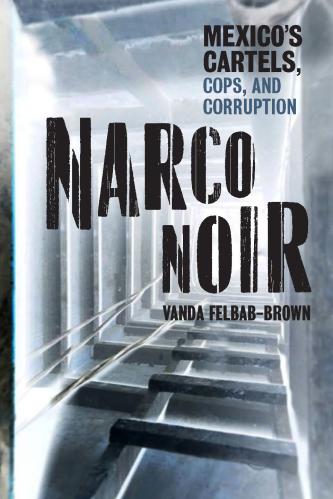
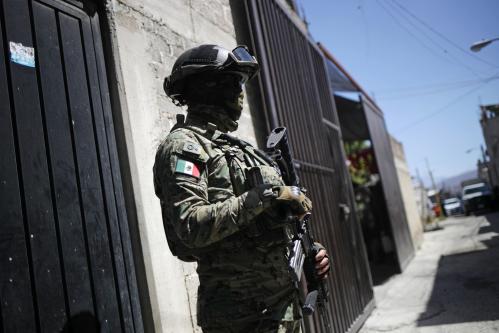
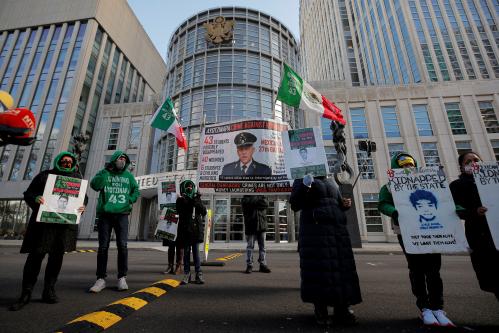
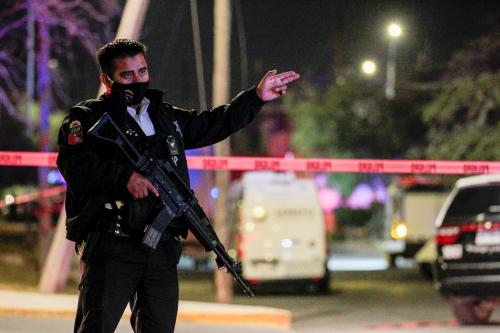


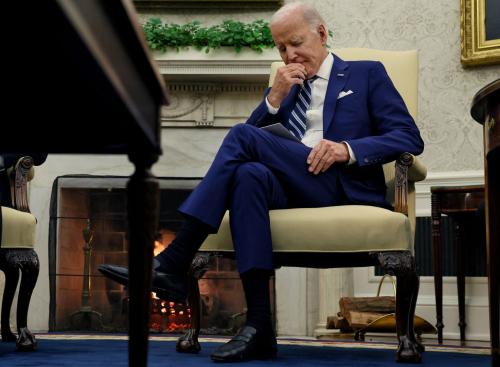

Commentary
US-Mexico security collaboration won’t be easily resurrected
July 30, 2021